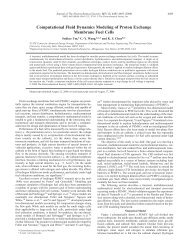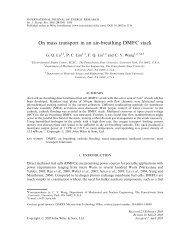Liquid Water Transport in Polymer Electrolyte Fuel Cells With Multi ...
Liquid Water Transport in Polymer Electrolyte Fuel Cells With Multi ...
Liquid Water Transport in Polymer Electrolyte Fuel Cells With Multi ...
- No tags were found...
Create successful ePaper yourself
Turn your PDF publications into a flip-book with our unique Google optimized e-Paper software.
shown that highly hydrophobic MPLs usually exhibit betterperformance (Wilson et al. 1995, Qi and Kaufman 2002 andKong et al. 2002). Although the exact mechanisms are yet to befully elucidated, the performance enhancement is usuallyassociated with better water management capabilities of MPLs.The two ma<strong>in</strong> effects of improvement with MPLs are due toenhancement of water management by better humidify<strong>in</strong>g themembrane, consequently decreas<strong>in</strong>g the ohmic losses andreduc<strong>in</strong>g the flood<strong>in</strong>g <strong>in</strong> cathode, consequently improv<strong>in</strong>g thegas phase diffusion.Although several studies have been carried out to modelthe two-phase transport <strong>in</strong> PEFCs, only a few has discussed theeffects of MPL on water management and two-phase transport.Nam and Kaviany (2003) have modeled the two-phasetransport <strong>in</strong> multi-layered cathode GDM us<strong>in</strong>g the unsaturatedflow theory (UFT), which assumes the gas pressure <strong>in</strong> the GDLis constant, therefore neglects the gas flow counter to the liquidflow. They have optimized the MPL properties accord<strong>in</strong>g to thetotal liquid water <strong>in</strong> the cathode GDM, and concluded that thereis an optimum for thickness and porosity of the MPL. Mostrecently, Pasaogullari and Wang (2004a), elucidated the effectof MPL, us<strong>in</strong>g the more complete two-phase model i.e. M 2formulation, which relaxes the constant gas phase pressureassumption, hence accounts for the gas flow counter to thecapillarity-<strong>in</strong>duced liquid flow. It was <strong>in</strong>dicated for the firsttime that the build-up <strong>in</strong> liquid pressure <strong>in</strong> the cathode due tothe presence of MPL creates a hydraulic pressure differential todrive water flow back to the anode. This water back flow canbe controlled by the pore size and wettability of MPL follow<strong>in</strong>gthe capillary flow theory developed by Pasaogullari and Wang(2004b). In addition, the study of Pasaogullari and Wang(2004a) revealed a capillary-driven enhancement of oxygentransport once the two-phase zone is formed. This newenhancement mechanism is, however, over-dom<strong>in</strong>ated by the<strong>in</strong>crease <strong>in</strong> the diffusion resistance, yield<strong>in</strong>g an overallreduction <strong>in</strong> the oxygen transport limitation <strong>in</strong> most cases offlood<strong>in</strong>g. In a meet<strong>in</strong>g abstract, Weber and Newman (2003)also mentioned the positive role played by MPL to promotewater back flow through the membrane, improv<strong>in</strong>g thehumidification of the membrane as well as the anode catalystlayer, reduc<strong>in</strong>g the overall ohmic losses, hence improv<strong>in</strong>g theperformance.The aim of the present work is to present a two-phase flowmodel for the entire membrane-GDM assembly, based on theM 2 formulation (Wang and Cheng, 1997) and analyze the liquidwater transport <strong>in</strong> PEFCs with MPLs. The effects of porous andwett<strong>in</strong>g structure of MPL are also analyzed. The paper isorganized as follows: The development of the mathematicalmodel for multi-layered GDM and polymer electrolytemembrane (PEM) is presented based on the theory of liquidwater flow <strong>in</strong> hydrophobic gas diffusion layers presented byPasaogullari and Wang (2004a). Then, the liquid watertransport with MPL is compared with the conventional PEFCconfigurations and the effects of MPL properties are exam<strong>in</strong>ed.MATHEMATICAL MODELThe present study focuses on liquid water transport <strong>in</strong>porous gas diffusion anode and cathode and across themembrane. The cell is considered to be isothermal as a firstapproximation. The gas channels are excluded from themodel<strong>in</strong>g doma<strong>in</strong> by specify<strong>in</strong>g boundary conditions at the gasdiffusion media/channel <strong>in</strong>terfaces. Furthermore, catalyst layersare taken to be <strong>in</strong>f<strong>in</strong>itely th<strong>in</strong>; and hence the anode hydrogenoxidation reaction (HOR) and cathode oxygen reductionreaction (ORR) are assumed to take place at the PEM-GDM<strong>in</strong>terfaces. <strong>With</strong><strong>in</strong> these assumptions, the doma<strong>in</strong> considered isconf<strong>in</strong>ed to porous anode GDL, PEM and cathode GDM,consist<strong>in</strong>g of MPL and GDL, as shown <strong>in</strong> Figure 1 along withthe associated transport processes. Although the present modelis developed <strong>in</strong> 1-D, it can be readily implemented <strong>in</strong> a multidimensionalCFD model with the channel <strong>in</strong>corporated asshown <strong>in</strong> Pasaogullari and Wang (2004c).In this study, the multi-phase, mixture model (M 2 ) isemployed to describe the two-phase transport processes <strong>in</strong> theporous media. M 2 model is an exact reformulation of classicaltwo-phase, two-fluid models <strong>in</strong>to a s<strong>in</strong>gle equation. Unlike theunsaturated flow theory (UFT) utilized <strong>in</strong> some of the earliertwo-phase PEFC models (He et al. 2000 Nam and Kaviany2003) M 2 model does not require the assumption of a constantgas phase pressure across the porous medium, hence it alsoaccounts for the gas flow counter to the capillarity driven liquidflow. Furthermore, M 2 model<strong>in</strong>g does not require explicitlytrack<strong>in</strong>g of phase <strong>in</strong>terfaces; consequently simplifiesmathematical model<strong>in</strong>g of two-phase transport <strong>in</strong> porousmedium, where both s<strong>in</strong>gle- and two-phase regions coexist. Thereader is referred to Wang and Cheng (1997) for details of themultiphase mixture model and its applications to a number ofmultiphase transport problems <strong>in</strong> porous media.Mass conservation for the two-phase mixture <strong>in</strong> steadystateas given by M 2 formulation is:∇ ⋅ ( ρ u ) = 0(1)In the above equation; u is the superficial mixture velocity andρ is the mixture density and given as:ρ = ρl⋅ s + ρg⋅ ( 1−s)(2)where s is the liquid saturation and represents the fraction ofopen pore space of porous media occupied by liquid.When Eq. (1) is <strong>in</strong>tegrated along the GDM <strong>in</strong> steady-state: ρ u =(3)where jmj m<strong>in</strong>dicates the net mass flux through the porous media,and correspond<strong>in</strong>g expressions for each <strong>in</strong>dividual layers aregiven <strong>in</strong> Table 1.The species conservation equation of M 2 formulation, whenwritten <strong>in</strong> terms of molar concentrations is (Pasaogullari andWang, 2004a):⎡⎛i i⎞ ⎤ieff iC ∇ ⋅ ( ) = ∇ ⋅ ( i ,∇ ) − ∇ ⋅ ⎢⎜mflgγ− ⎟cuCDgCgjil ⎥(4)⎢⎣⎝ M ρg⎠ ⎥⎦where the advection correction factor is:⎧ ⎛H 2Oρ⎞⎪ ⎜λlCsat+ λ ⎟ for waterH O⎪H O g22C= ⎝ M ρ ⎠(5)gγi ⎨⎪ ρλg⎪for other species⎩ρ( 1−s)In Eq. (4), C i denotes the total molar concentration of species i<strong>in</strong> liquid and gas phases, def<strong>in</strong>ed as:ii iC = ( 1 − s) Cg+ sC(6)lThe gas-phase diffusion coefficient,i effD , is corrected forgtortuosity and reduction <strong>in</strong> the open pore space due to presenceof liquid water via Bruggeman correlation, i.e.:2 Copyright © 2004 by ASME




